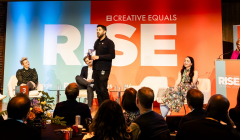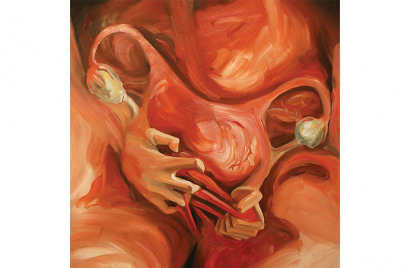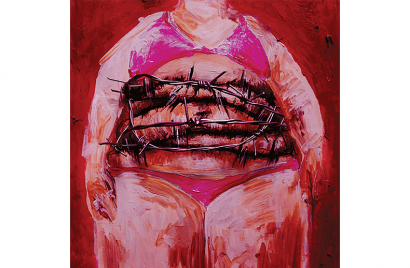
Are we leaving men and boys behind?
At Creative Equal’s RISE event, industry leaders consider how to reframe boys and men in marketing

The creative team behind Essity’s ground-breaking #painstories campaign lift the lid on the normalisation of women’s pain in culture and the brand’s truth-telling work.

Is pain simply the cost of entry for existing in a woman's body? It's a profound question answered with authenticity, creativity and understanding of the lived experiences of women in Essity’s groundbreaking #painstories campaign created by AMV BBDO and brought to life by Ketchum.
The work follows in the footsteps of Essity’s #bloodnormal and #wombstories campaigns in breaking the stigma and silence that surrounds women’s bodies by listening to and reflecting their lived experiences with not even a speck of squeamishness or unidentifiable blue liquids substituting for blood.
As a body of creative work, the campaigns underline the power of truth in advertising. Nadja Lossgott, Executive Creative Director at AMV BBDO, describes #painstories as an extension of the brand’s #wombstories campaign, which lifted the lid on the lived experience of being a woman from infertility to heavy periods, pregnancy and endometriosis. “We are on a truth telling journey,” she explains. “The truth we unlocked in #wombstories was the role of the womb as that second seat of power that rules you in so many ways,” she adds.
There is this very homogenous misrepresentation of women’s bodies and this is why lived experience is at the very core of this campaign. There is not enough truth.
Lauren Peters
The lived reality of women’s pain came to the fore in the #wombstories project, an authentic understanding which is rooted in the brand’s approach and commitment to active listening. The creative journey for #wombstories involved stripping back the squeamishness which still surrounds women’s bodies and using art and creativity to bring experiences that had often remained unsaid, or pushed aside, to life.
“Within #wombstories, pain and endometriosis were such clear experiences, and many women had such a visceral reaction to that pain. We know that research is underfunded, and a lot of women don’t know they are living with it. Women’s pain is dismissed on a daily basis,” explains Lossgott.
This respect for active listening also extends to the lived experiences of the women behind the work. Augustine Cerf, Copywriter at AMV BBDO, has brought the empathy of living through her own debilitating pain to the creative process. It's an empathy which contributes to a rich visual language, which delivers that most powerful of creative tools: a sense of being truly seen.
“I’ve experienced that pain and I have never seen that pain articulated. The reality is when pain is experienced it doesn’t always feel like you can explain it,” she says.
Often when it comes to establishing pain levels, individuals are asked to rank the pain from one to 10. A blunt tool which may lead to the devastating lack of acknowledgement and misunderstanding which still surrounds women’s pain.
The author and campaigner Caroline Criado Perez articulates this data blind spot as “reference man”, an ecosystem in which medical research is based around the ‘norm’ of the male body, immediately rendering women’s experience as ‘other’ and therefore invisible by design. Her book Invisible Women examines the way in which healthcare systematically discriminates against women, leaving them chronically misunderstood, mistreated and misdiagnosed.
“The pain scale of one to 10 is so subjective,” explains Cerf. “My pain can really undulate, and we are programmed to forget our pain. When we go to the doctor, we are made to play our pain down and I have been told that I must have a low pain threshold,” she explains.


The truth of this pain is brought to life in the artwork which accompanies the campaign’s Pain Dictionary. The artwork from this Pain Dictionary is exhibited in the world's first Pain Museum created by Ketchum. This virtual space explores the campaign in detail and includes interviews with women sharing their own experience of pain in their own words.
The visual representation of pain, which is also shared in an Insta-book on Instagram, brings the oxygen of truth to women’s silent pain.
Lauren Peters, Art Director at AMV BBDO, explains that art was at the centre of bringing this pain to life because, “a lot of the ways in which people understand and relate to pain is through visualisation.”
She continues: “The way to give justice to women’s pain was to use a really wide range of artists, some of whom had suffered with endometriosis themselves, with illustrations like misery roulette, which show the range of different pain and also art that really tapped into specific feelings and brought those feelings to life through images such as barbed wire.”
The team reached out and tapped into the creativity of the women in the online endometriosis community. Through their self-expression and artists telling their own stories of pain through their work, the range and intensity of their experiences comes through. “It's not all dark,” explains Peters. “There are moments of relief and some people have softer and different experiences.”
The power of this visual expression of pain translates to a sense of being seen by those suffering. “For those with endometriosis it was great to see that they felt their experiences were articulated. It is all about empathy and understanding,” explains Peters.
This reflection and respect for the lived experiences of women lies at the heart of the campaign. “There is this very homogenous misrepresentation of women’s bodies and this is why lived experience is at the very core of this campaign. There is not enough truth,” she adds.
For Lossgott, it is crucial that this lived experience is channelled through every single piece of work and met with authenticity at all stages of the creative process. “Women have always been deemed to be this neat biological package. The idea of showing the unique truth, those horror show moments of pain is important,” she explains.
Lossgott revealed her own experience of going to A&E in severe pain and being given little more than a paracetamol. That visceral visual experience of pain being properly articulated is core to the heart of this campaign. It’s an appreciation shared by Cerf, who reveals that her partner gained a greater understanding and empathy for her pain through the images in the dictionary.
Our starting point is what can be ground-breaking. That’s where Essity wants to be; to break the taboo, to push the boundaries and open the door to others.
Nadja Lossgott
The team hopes that the Pain Dictionary can become a practical tool for women to start new conversations both within medical settings and amongst friends and communities. Cerf explains: “We really want it to be a practical tool and for it to be used by GP’s surgeries.”
Notably the virtual Pain Museum, at a time in which museums and galleries remain closed as a result of the coronavirus pandemic, provides a space to consider this unacknowledged pain. “The interesting point about this existing as an online space is that you can be both very public and very private,” Cerf adds.
“The pandemic has exaggerated what was already there,” says Lossgott, noting that the pandemic can make individual experiences and agendas feel unseen. “The strategy behind the work is 100% the same as it was prior to the pandemic, but the pandemic has made some of these challenges and experiences resonate more,” she adds.
In light of the disproportionate impact of the coronavirus crisis on women, Cerf adds that it is important to keep momentum. “It’s important to keep pushing, we need to keep living and keep moving,” she says.
The #painstories campaign continues the purpose-driven path forged by #Bloodnormal and #Wombstories, campaigns which have become synonymous with best-in-class examples of effective genre-defying, purpose-driven marketing campaigns.
At the same time a clutch of marketing commentators have continued to question and challenge the importance and relevance of purpose for the industry at large. Despite these debates there is no question that purpose continues to drive up the marketing agenda.
Yet brands need to be looking to generate more than just headlines or one-off marketing campaigns if they are serious about embracing purpose. “There are brands that will say they will do purpose because they know it is successful, but the question is do they 100% live it in their values?” explains Lossgott.
“There is always more to do,” she continues, adding: “We are exceptionally lucky with our partner Essity because they 100% believe in creativity and authenticity to drive change and to drive the business. It’s good for the world and it's also good for business.”
This commitment to creativity demands that the team isn’t complacent in its approach to breaking stereotypes. It’s an approach underlined in its unflinching portrayal of pain, a subject that many brands would simply be too afraid to tackle.
“You don’t want to become the cliche of a cliche,” explains Lossgott. “The use of a real person in an advert is not ground-breaking. So, you have to push forward. There is even a term for it now, ‘femvertising’. We were very clear that we didn’t want to become a copy of ourselves.”
It’s an approach which keeps the brand well clear of cliches and that very blackest of creative holes, becoming a parody of themselves. “Our starting point is what can be ground-breaking,” explains Lossgott. “That’s where Essity wants to be; to break the taboo, to push the boundaries and open the door to others.”
Or in the case of #painstories, to give voice to experiences of pain that for decades have remained unseen, misunderstood and desperately underacknowledged.
Normalising women's pain can have devastating consequences.
One in five women and men think that women shouldn’t complain about the pain they experience during their period.
In fact, 51% of women and 52% men agree that period pain is something that women have to deal with. Historically women’s pain has been synonymous with hysteria.
According to Painstories, 79% of women haven’t sought help from a doctor or healthcare professional despite worrying symptoms.
Looks like you need to create a Creativebrief account to perform this action.
Create account Sign inLooks like you need to create a Creativebrief account to perform this action.
Create account Sign in